
Daphnis nerii, the oleander hawk-moth or army green moth, is a moth of the family Sphingidae. It was described by Carl Linnaeus in his 1758 10th edition of Systema Naturae.

Hippotion celerio, the vine hawk-moth or silver-striped hawk-moth, is a moth of the family Sphingidae. It was described by Carl Linnaeus in his 1758 10th edition of Systema Naturae.

Calinaga buddha, the freak, is a species of butterfly in the Calinaginae subfamily that is found in parts of Southeast Asia, China and in India.

Utetheisa pulchella, the crimson-speckled flunkey, crimson-speckled footman, or crimson-speckled moth, is a moth of the family Erebidae. The species was first described by Carl Linnaeus in his 1758 10th edition of Systema Naturae.
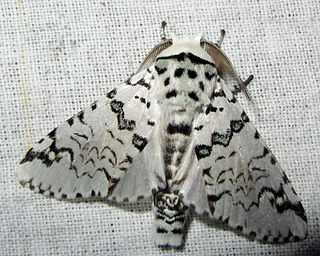
Cerura liturata is a moth of the family Notodontidae described by Francis Walker in 1855. It is found from the Oriental tropics of India, Sri Lanka to Sundaland.
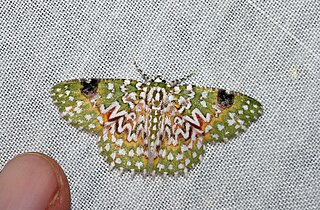
Eucyclodes gavissima, the Oriental orange banded green geometer moth, is a species of moth of the family Geometridae described by Francis Walker in 1861. It is found in the Indian subregion, Sri Lanka, Bhutan, western China, Taiwan, Sumatra and Borneo.

Condica dolorosa is a moth of the family Noctuidae. It is found in the Indo-Australian tropics, including Borneo, Hawaii, Hong Kong, India, Sri Lanka, Taiwan and Queensland in Australia.

Cyana puella is a moth of the family Erebidae. It is found in the north-western Himalayas, Nepal, India, Sri Lanka, Madagascar, Kenya and Eritrea.

Cyana peregrina is a moth of the family Erebidae. It is found in India and Sri Lanka. The habitat consists of forests.
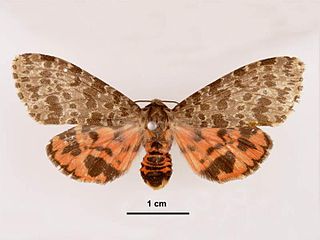
Olepa ricini is a moth of the family Erebidae first described by Johan Christian Fabricius in 1775. It is found in Bangladesh, India, Nepal, and Sri Lanka. An older treatment placed the species in the genus Pericallia.

Olepa ocellifera is a moth of the family Erebidae first described by Francis Walker in 1855. It is found in India and Sri Lanka.

Orgyia postica, the cocoa tussock moth or hevea tussock moth, is a species of moth of the subfamily Lymantriinae of family Erebidae found from the Oriental tropics of India, Sri Lanka, Myanmar, Borneo, Java, New Guinea and Taiwan. It was described by Francis Walker in 1855.

Gesonia obeditalis is a species of moth of the family Noctuidae first described by Francis Walker in 1859. It is found from eastern Africa, the Seychelles, the Maldives and the Oriental tropics of India, Sri Lanka east to the Philippines, the Sula Islands and Australia. The adult moth has brown wings with a scalloped dark brown band near the margin. The hindwings are similar in pattern to the forewings but are a paler shade of brown.

Erruca cardinale is a moth of the family Erebidae and described by George Hampson in 1898. It is found in Brazil. While São Paulo was where E. cardinale was first encountered, this moth is also found in other parts of Brazil like Santa Catarina, specifically in the towns of Bom Jardim da Serra, Brusque, Joinville and São Bento do Sul. Erruca cardinale is described as a day-flying moth, meaning that unlike most species of moth it is active during the day and sleeps at night. In volume one of the Catalogue of the Lepidoptera Phalaenae (1898) E. cardinale is described as follows:
Black-brown; antennae white at tips; tegulae with white points; patagia with crimson patches; legs with white spots; abdomen with lateral patches of crimson at base, and dorsal and two lateral series of white points, the 1st dorsal spot large; wings hyaline, the veins and margins black. Fore wing with crimson spot below base of median nervure and patch on basal part of inner margin followed by a whiteish mark; a discocellular black patch; the terminal band very wide on apical area and expanding at tornus; cilia white at apex. Hind wing with the innter area brilliant crimson; the terminal band expanding slightly at apex and above tornus.

Euchromia polymena is a moth of the subfamily Arctiinae. It was described by Carl Linnaeus in his 1758 10th edition of Systema Naturae. It is found in India and south-eastern Asia, as well as on Sumatra, Java, Sulawesi, Peninsular Malaysia, Borneo and the Philippines. It is also present in the northern part of Western Australia and the Northern Territory.
Lemyra subfascia is a moth of the family Erebidae. It was described by Francis Walker in 1855. It is found in Sri Lanka.

Macrobrochis gigas is a moth of the family Erebidae. It was described by Francis Walker in 1854. It is found in China (Yunnan), India (Sikkim), Bhutan, Nepal, Indonesia, Hong Kong and Taiwan. The habitat consists of woodlands.
Rajendra biguttata is a moth in the family Erebidae. It was described by Francis Walker in 1855. It is found from southern India to north-eastern India and in Bangladesh and Sri Lanka.
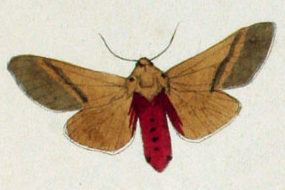
Spilosoma melanopsis is a moth in the family Erebidae. It was described by Francis Walker in 1865. It is found in Sri Lanka.
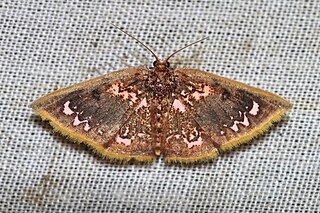
Chrysocraspeda abhadraca is a species of moth in the family Geometridae described by Francis Walker in 1861. It is found in Indian subregion including India and Sri Lanka, Peninsular Malaysia, Sumatra and Borneo.


















